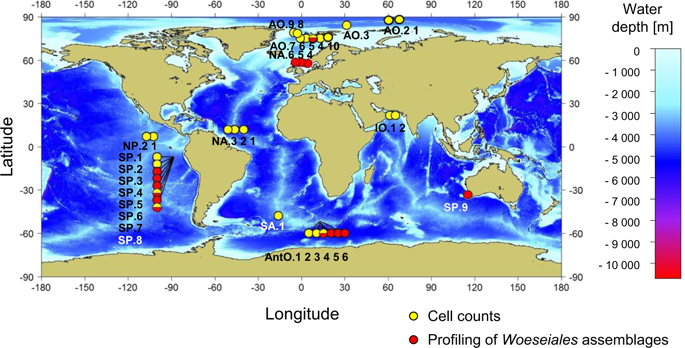Our official English website, www.x-mol.net, welcomes your feedback! (Note: you will need to create a separate account there.)
Diversity and metabolism of Woeseiales bacteria, global members of marine sediment communities.
The ISME Journal ( IF 11.0 ) Pub Date : 2020-01-27 , DOI: 10.1038/s41396-020-0588-4 Katy Hoffmann 1, 2 , Christina Bienhold 1, 2 , Pier Luigi Buttigieg 1, 2 , Katrin Knittel 3 , Rafael Laso-Pérez 1 , Josephine Z Rapp 1, 2, 4 , Antje Boetius 1, 2, 5 , Pierre Offre 1, 6
The ISME Journal ( IF 11.0 ) Pub Date : 2020-01-27 , DOI: 10.1038/s41396-020-0588-4 Katy Hoffmann 1, 2 , Christina Bienhold 1, 2 , Pier Luigi Buttigieg 1, 2 , Katrin Knittel 3 , Rafael Laso-Pérez 1 , Josephine Z Rapp 1, 2, 4 , Antje Boetius 1, 2, 5 , Pierre Offre 1, 6
Affiliation

|
Surveys of 16S rRNA gene sequences derived from marine sediments have indicated that a widely distributed group of Gammaproteobacteria, named "JTB255-Marine Benthic Group" (now the candidate order Woeseiales), accounts for 1-22% of the retrieved sequences. Despite their ubiquity in seafloor communities, little is known about their distribution and specific ecological niches in the deep sea, which constitutes the largest biome globally. Here, we characterized the phylogeny, environmental distribution patterns, abundance, and metabolic potential of Woeseiales bacteria with a focus on representatives from the deep sea. From a phylogenetic analysis of publicly available 16S rRNA gene sequences (≥1400 bp, n = 994), we identified lineages of Woeseiales with greater prevalence in the deep sea than in coastal environments, a pattern corroborated by the distribution of 16S oligotypes recovered from 28 globally distributed sediment samples. Cell counts revealed that Woeseiales bacteria accounted for 5 ± 2% of all microbial cells in deep-sea surface sediments at 23 globally distributed sites. Comparative analyses of a genome, metagenome bins, and single-cell genomes suggested that members of the corresponding clades are likely to grow on proteinaceous matter, potentially derived from detrital cell membranes, cell walls, and other organic remnants in marine sediments.
中文翻译:

海洋沉积物群落的全球成员Woeseiales细菌的多样性和代谢。
对来自海洋沉积物的16S rRNA基因序列进行的调查表明,名为“ JTB255-海洋底栖动物群”(现为候选Woeseiales)的广泛分布的γ变形细菌群占检索到的序列的1-22%。尽管它们在海底社区中无处不在,但关于它们在深海中的分布和特定生态位却知之甚少,深海是全球最大的生物群落。在这里,我们表征了Woeseiales细菌的系统发育,环境分布模式,丰度和代谢潜力,重点是来自深海的代表。通过对公开可用的16S rRNA基因序列(≥1400bp,n = 994)进行系统发育分析,我们确定了深海地区比沿海地区普遍存在的Woeseiales血统,从全球28个沉积物样本中回收的16S寡聚体的分布证实了这种模式。细胞计数表明,Woeseiales细菌占全球23个分布点深海表层沉积物中所有微生物细胞的5±2%。对基因组,元基因组箱和单细胞基因组的比较分析表明,对应进化枝的成员可能在蛋白质物质上生长,可能来自碎屑细胞膜,细胞壁和海洋沉积物中的其他有机残余物。
更新日期:2020-01-29
中文翻译:

海洋沉积物群落的全球成员Woeseiales细菌的多样性和代谢。
对来自海洋沉积物的16S rRNA基因序列进行的调查表明,名为“ JTB255-海洋底栖动物群”(现为候选Woeseiales)的广泛分布的γ变形细菌群占检索到的序列的1-22%。尽管它们在海底社区中无处不在,但关于它们在深海中的分布和特定生态位却知之甚少,深海是全球最大的生物群落。在这里,我们表征了Woeseiales细菌的系统发育,环境分布模式,丰度和代谢潜力,重点是来自深海的代表。通过对公开可用的16S rRNA基因序列(≥1400bp,n = 994)进行系统发育分析,我们确定了深海地区比沿海地区普遍存在的Woeseiales血统,从全球28个沉积物样本中回收的16S寡聚体的分布证实了这种模式。细胞计数表明,Woeseiales细菌占全球23个分布点深海表层沉积物中所有微生物细胞的5±2%。对基因组,元基因组箱和单细胞基因组的比较分析表明,对应进化枝的成员可能在蛋白质物质上生长,可能来自碎屑细胞膜,细胞壁和海洋沉积物中的其他有机残余物。



























 京公网安备 11010802027423号
京公网安备 11010802027423号